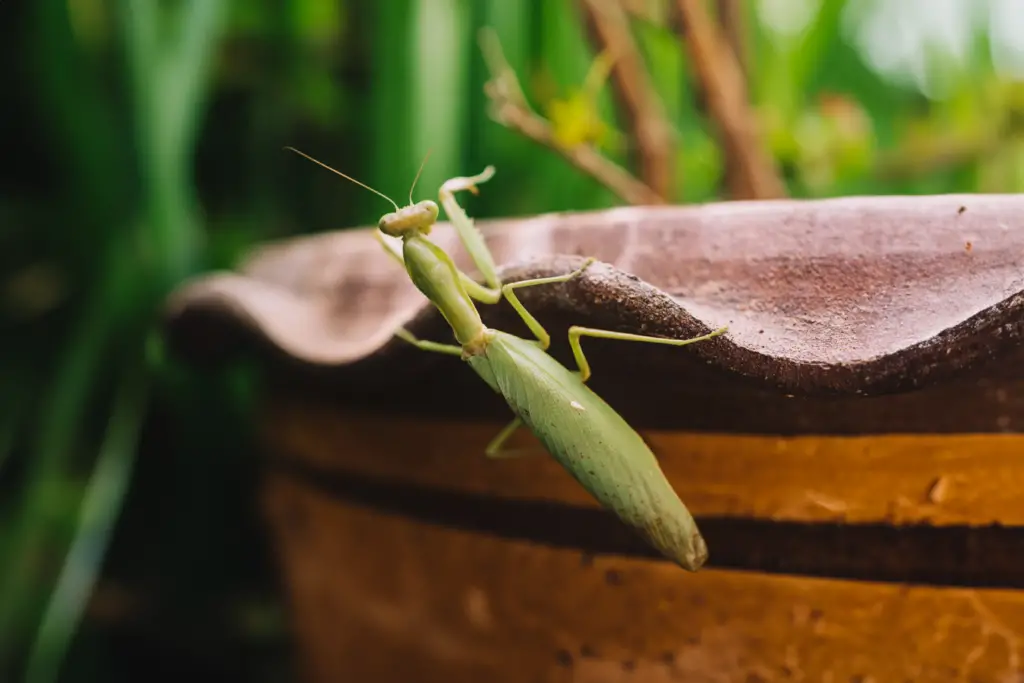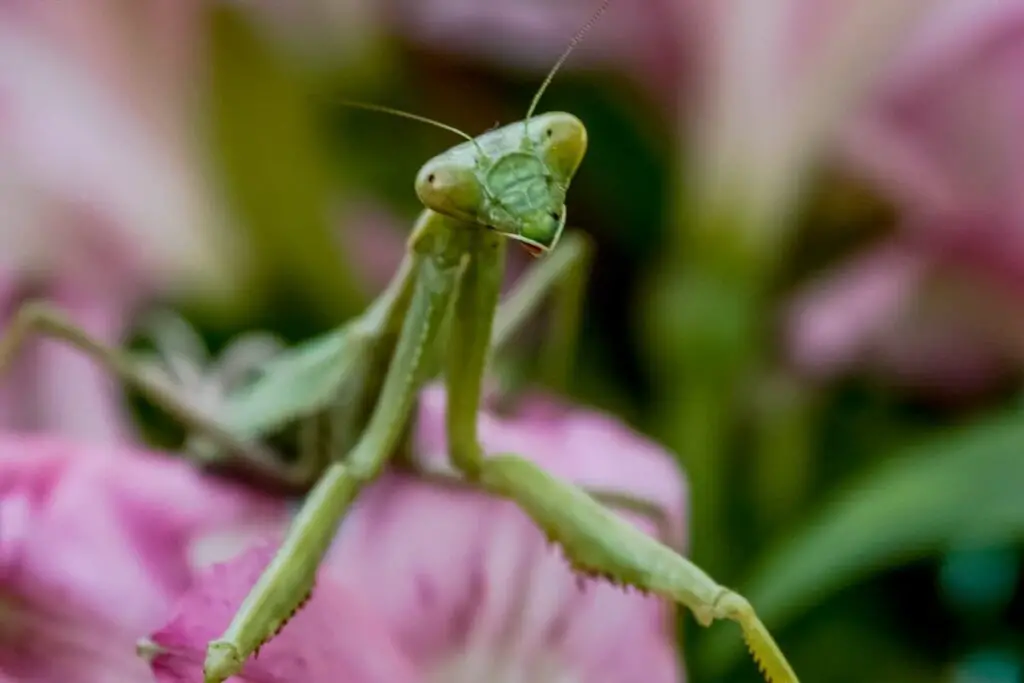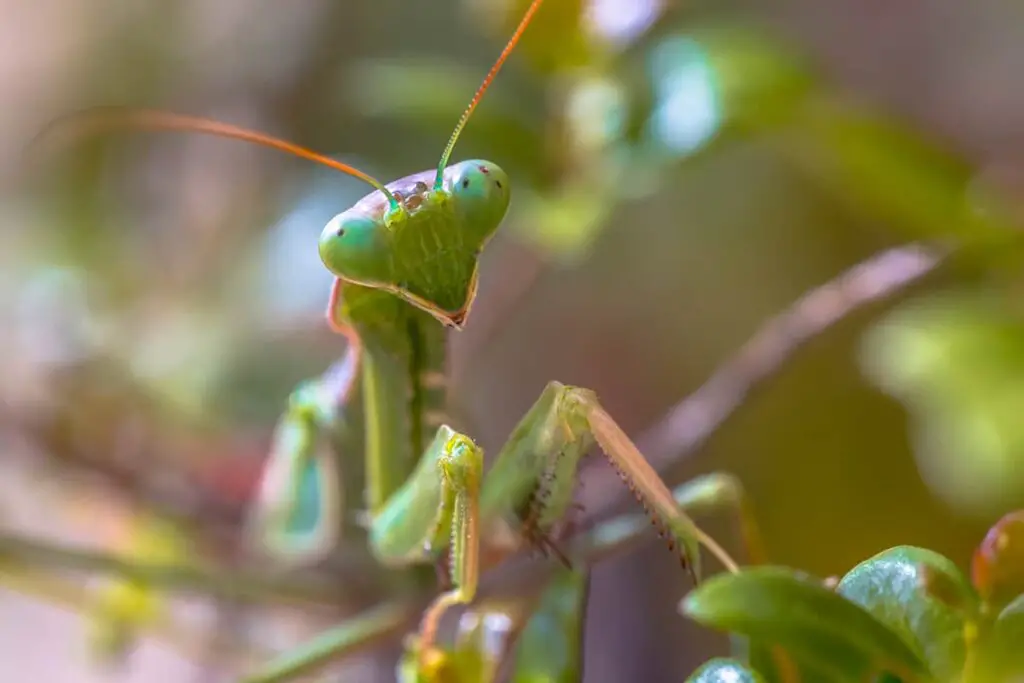
Creating a sanctuary for your praying mantis is both an exciting and rewarding venture. It gives you the opportunity to observe these fascinating creatures up close, as they showcase their curious behaviors and intricate appearances. Essential to their health and happiness, the right habitat replicates conditions found in the wild, providing a safe and comfortable environment for mantises to thrive.
As with any pet, understanding the needs of your praying mantis is crucial to its care. Your primary goals should include maintaining proper humidity levels, ensuring adequate ventilation, and offering plenty of space for climbing and molting. Catering to these needs will promote a healthy life cycle for your mantis, from its predatory prowess to its unique molting process.
Mantis Natural Habitat Characteristics
Mantises, fascinating insects you might recognize readily by their distinctive praying stance, thrive in a variety of environments worldwide. Despite their differing locales, mantis habitats share common traits essential for their survival.
Diverse Climates:
You’ll find mantises in temperate and tropical habitats. They manage well in both hot and mildly cooler climates, showing remarkable adaptability.
Vegetation for Camouflage:
Mantises are masters of disguise, blending in flawlessly with the surroundings. Dense shrubs, grassy areas, and leafy forests provide perfect cover, allowing mantises to avoid predators and ambush prey.Hunting and Mating Grounds:
These environments not only give them cover but also serve as excellent hunting and mating grounds, crucial for their life cycle.
Water Sources:
Access to water is key, and while mantises don’t need much, they do require a humid environment for their overall health.
These settings provide all a mantis needs: concealment, plentiful prey, and opportunities to meet others for reproduction. If you have a garden, you might be lucky to spot these remarkable creatures patiently awaiting their next meal. Remember, while not needing a lot, the presence and health of mantises can be a good indicator of the environmental quality of their habitat.
Essential Environmental Conditions
Creating a hospitable environment for your mantis ensures their health and happiness. Focus on the details of temperature and humidity, the right plants, and the correct soil composition.
Temperature and Humidity
Your mantis’s well-being hinges on maintaining optimal temperature and humidity levels. Aim for temperatures between 75°F to 80°F to simulate their natural conditions. Humidity is also pivotal, so keep it at a consistent 60% to 70% to support their needs.
Plants and Foliage
Incorporate live plants and foliage into your mantis habitat; these elements provide essential hiding and hunting grounds. Choose plants that resemble their native environment. For example, adding a variety of fauna will make your mantis feel more at home.
Soil Composition and Texture
The soil in your mantis habitat should mimic natural substrates they’re accustomed to, aiding in moisture retention and providing a naturalistic aspect. A blend of peat, sand, and organic compost can offer the right composition and texture for your mantis to thrive.
Dietary Requirements for Mantis Health
To maintain your mantis’s health, you must ensure a varied and nutritious diet. Mantises are predatory insects who thrive on live prey which stimulates their natural hunting behaviors.
Live Prey Options:
- Fruit flies: Ideal for young, small mantises.
- Crickets: A staple that is suitable for most mantises.
- Moths and butterflies: Offer an engaging flying challenge.
Consistency in feeding is crucial. Feed your mantis every 2 to 3 days, but adjust based on their lifecycle stage and appetite.
Feeding Schedule:
- Nymphs (young mantises): Daily feeding of appropriately sized prey.
- Adults: Larger prey less frequently, maintaining a healthy weight.
Supplementation can boost your mantis’s diet, providing essential nutrients not always present in captive prey.
Nutritional Supplements:
- Calcium dust: Promote exoskeleton strength by occasionally coating the insects with calcium powder.
Remember to provide clean water by misting the enclosure regularly. Proper hydration supports metabolic processes and overall well-being.
Observe your mantis during feedings to ensure it’s eating well and appears active. Any significant change may signal a health issue requiring attention. For more detailed dietary needs across their life cycle, you might want to read about mantis nutrition.
Common Threats and Conservation Efforts
Your fascinating garden ally, the praying mantis, faces several threats that endanger their habitats.
- Habitat Destruction: The expansion of urban areas and changes in land use can lead to the loss of suitable living spaces for mantises.
- Pesticides: Chemicals used in agriculture can be toxic to these beneficial predators, reducing their numbers.
- Climate Change: Altered weather patterns can disrupt the delicate balance of ecosystems supporting mantis populations.
Conservation efforts are crucial to safeguard these natural pest controllers. Some initiatives you can support or get involved in include:
- Creating Insect Hotels: Provide a safe haven for these critters in your own backyard.
- Reducing Pesticide Use: Embrace organic gardening to help maintain healthy mantis populations.
- Promoting Awareness: Educate your community about the importance of mantises and how they can help protect them.
To learn more about these majestic insects and help in their conservation, explore the Charismatic Praying Mantid: A Gateway for Insect Conservation. Additionally, understanding the broader picture of Biodiversity Risks and Conservation Challenges can equip you with the necessary tools to make a difference. Remember, your actions, no matter how small, can contribute to the preservation of these extraordinary insects.
Frequently Asked Questions
In this section, you’ll find answers to common inquiries about creating a thriving environment for your mantis friend.
How should I set up a proper enclosure for a praying mantis?
Your mantis’s enclosure should be around three times its body length in height and twice the width to allow for movement and molting. Proper ventilation is key, and a combination of space and mesh can help create a suitable mantis habitat.
What types of plants are most beneficial for a praying mantis habitat?
Incorporating live plants such as marigolds or common ivy can provide climbing spaces and replicate the mantis’s natural environment. Choose plants that don’t require pesticides, as these can harm your pet.
What is an ideal diet for a praying mantis living in captivity?
Offer a variety of live insects, including flies, moths, and small crickets. The diet of a mantis can influence its health, so ensure the prey is appropriate for the size of your mantis.
Where can I purchase a praying mantis for my habitat?
Praying mantises are available through reputable online vendors, pet stores, or insect hobbyist groups. Always choose a source that provides healthy and ethically-sourced specimens.
What are the drawbacks of keeping a praying mantis as a pet?
The short lifespan of mantises and their specific habitat requirements can be challenging. They may also display cannibalistic behavior if housed together, which requires careful management.
How does a praying mantis adapt to its environment?
Mantises are adaptable predators with excellent camouflage. They modify their hunting techniques based on the prey available in their habitat. In captivity, they will adjust to the environment you create, as long as it meets their basic needs.
Driven by a passion for those tiny creatures that rule our world, we at Bug Domain strive to be your go-to resource for information on insects.



